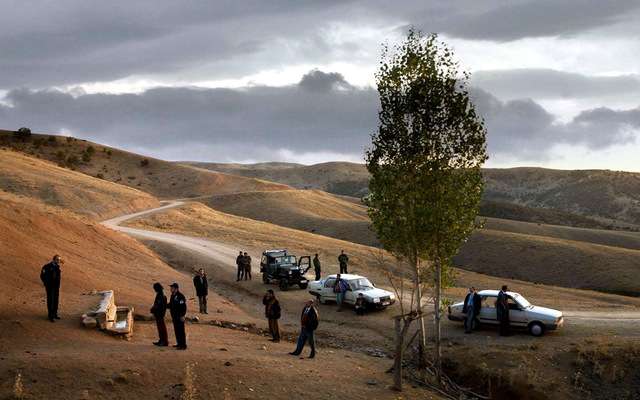-
Nuri Bilge Ceylan: Once Upon a Time in Anatolia (2011)
NURI BILGE CEYLAN: ONCE UPON A TIME IN ANATOLIA (2011)

A long and winding road to an autopsy
I can do no better than Mike D'Angelo's appreciative but unconvinced report on the Turkish direictor Nuri Bilge Ceylan's new film, Once Upon a Time in Anatolia. Here's what D'Angelo posted for the AV Club from Cannes last May: "The latter is an intelligent, meticulous, incredibly beautiful movie that’s offered plenty of food for thought since I saw it, but that I found downright torturous to actually sit through. Mostly, that’s because Ceylan is playing a deliberate, formalist game of keep-away, introducing what looks on the surface like an exciting narrative—the film opens at night, with a bunch of cops and other officials toting two criminals around gorgeously barren landscapes in search of a corpse—only to slow the 'action' to a crawl (it takes 90 minutes of this two-and-a-half hour movie just for them to find the body) and focus our attention on bureaucratic trivia and raw bits of the characters’ psyches. Ceylan knows precisely what he’s doing—a lengthy shot of an apple tumbling downhill into a stream, merely to come to rest beside other rotted apples, all but chides us for seeking direct answers—and he uses car headlights the way Kubrick used candles in Barry Lyndon, but I still had enormous trouble staying alert amidst the endless trudging and sniping and sharing of seemingly random anecdotes."
He doesn't trust his reaction, pleading that he saw it late at night (he tends to have five-film days at festivals) and thinks Cannes' high regard (this co-won the Grand Prize with the Dardennes' estimable and consistent The Kid with the Bike) means he "might want to take a second look in future."
When he's on point as he is here, D'Angelo is vivid and accurate, and I can only agree that the wide aspect photography, with its tinges of yellow and digital luminosity, is gorgeous in the early segments as the three cars trail through the stark flat hills, so much so that simply watching the images is a pleasure in itself. The sudden alternating, contrasting closeups of men packed into a car, an aggressive police officer who's tried to stop smoking, a man they call "Arab" who does the driving, a sly, quiet doctor (who emerges as the film's favorite character) and a well-dressed prosecutor with a pock-marked face, with the main prisoner in the middle in the back, and the endless trivial conversation -- all this seems just an ironic joke to contrast with the beautiful landscape outside, which is heightened by thunder and lightning and a threat of heavy rain (which never comes).
Then there is the starting and stopping, the prisoner, angular and gypsy-like, abused by the police officer and his cohorts, repeatedly saying no, this isn't the place. They are trying to find where he buried a man he killed.
After a while when it's very late but still dark, they all stop, three cars, at a small village, where the local mukhtar (mayor) gives them dinner, and they are served by his young, beautiful daughter, who brings in a tray of tea with an array of small lamps that remind one even more of Kubrick's use of candles in Barry Lyndon, if you're so inclined. The prisoner, who dines with them, comes up with a confusing revelation. And then they go on and by the time it becomes light, the prisoner finds the burial place and they dig up the corpse of the man he killed, and there's a fuss about the fact that the dead man has been hog-tied, which turns into a mordant joke when they prepare to haul the dead man back with them to their town.
And everyone is exhausted, we too, and finally there is a rather gruesome autopsy, as the doctor peers out a big window and sees the murdered man's widow and her young son, who has a haunting face, wander away over a hill with a crowd of small boys playing below them.
If that floats your boat, rush to see Once Upon a Time in Anatolia. (The Cinema Guild has acquired U.S. distribution rights.) Ceylan has done fine, resonant, wry work in the past, but he goes very much his own stubborn way -- perhaps this time too much so. I would suggest that this, for all its meticulously observed characters and almost real-time examination of a curiously uninteresting and yet in some ways haunting police procedural, is more in the order of an auteurist shaggy dog story than anything I've seen before at the New York Film Festival at Lincoln Center, where it was screened for this review. Here, as at Cannes for Mike D'Angelo, it was "downright torturous to actually sit through." Since Cannes, it has been in at least eight other festivals, including Toronto. It will be released theatrically in Turkey, Greece, and France in September, October, and November, respectively.
Last edited by Chris Knipp; 09-30-2011 at 07:12 PM.
 Posting Permissions
Posting Permissions
- You may not post new threads
- You may not post replies
- You may not post attachments
- You may not edit your posts
-
Forum Rules





 Reply With Quote
Reply With Quote
Bookmarks